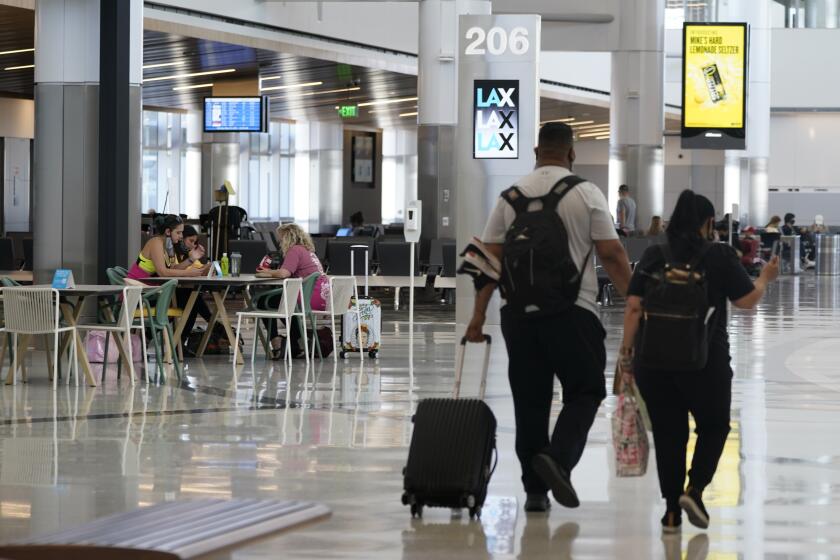RTD OKs Plans to Extend Metro Rail Into the Valley
- Share via
Amid continuing financial uncertainty, a rancorous, flip-flopping RTD board of directors on Thursday approved the route for the second phase of an all-subway Metro Rail, extending the future transit system through Hollywood and into the San Fernando Valley.
The $2.12-billion proposal--if funded and constructed--would give Los Angeles a total of 17.7 miles of subway with 16 stations along the route. The first segment--a 4.4-mile, $1.25-billion subway from Union Station to Wilshire Boulevard and Alvarado Street--is under construction and expected to be in operation in 1993. Until Thursday, there was no agreed-upon routing for the second phase.
For the record:
12:00 a.m. July 16, 1988 For the Record
Los Angeles Times Saturday July 16, 1988 Home Edition Part 1 Page 2 Column 1 Metro Desk 2 inches; 51 words Type of Material: Correction
A map published Friday to show the proposed Los Angeles Metro Rail project was incorrect. The route will follow Hollywood Boulevard instead of Sunset Boulevard as shown, and the map should have shown the line branching north from Hollywood Boulevard and highland Avenue, with an additional station at the location instead of from Sunset Boulevard and Vine Street.
In taking its action, the RTD board essentially affirmed its preference for the future route of Metro Rail but was unable to provide guarantees for how much of the system will be built.
Transit officials now estimate that only $1.42 billion is available for Metro Rail beyond the first phase. The board authorized RTD administrators to seek another $700 million in federal, state and local revenues in hopes of making the full second phase a reality.
In the meantime, transit officials are also working on a series of alternatives in case efforts for full funding fail. For example, some planned stations may be skipped, or the northernmost extension, from Universal City to North Hollywood, may have to be dropped, Metro Rail General Manager William Rhine said.
In establishing North Hollywood as the hoped-for destination, the RTD board acceded to the recommendation made Wednesday by the Los Angeles City Council over the suggestion of its own staff. The RTD staff had proposed a second phase with Universal City as its final destination.
The decision came in an emotion-charged meeting marked by sharp divisions among RTD board members. At one juncture, the board narrowly approved the route. Moments later, the board agreed to reconsider its decision and then narrowly rejected it. Later, the board reconsidered the matter again--and narrowly approved it.
A major sticking point was the issue of whether a station should be placed at the Hollywood Bowl or at the intersection of Hollywood Boulevard and Highland Avenue in the heart of the Hollywood redevelopment area, a site favored by the Los Angeles City Council and the one ultimately adopted.
In the midst of the reversals, board member Carmen Estrada--an appointee representing the city of Los Angeles--angrily declared that she felt “almost publicly humiliated by this board’s actions. . . . The reason is we flip-flop on very significant issues.”
Acknowledging controversy that has dogged the RTD through its operation of the bus system and Metro Rail, Estrada added, “We’re making the best argument ever for getting rid of the board.” The comment drew cheers from some community activists and other members of the audience.
If the board rejected the route, Estrada said, “I will do my best to get rid of this board.” The city of Los Angeles, she said, “is getting the shaft.”
But influential board Vice President Marv Holen, long a backer of the Hollywood Bowl station, suggested that the City Council preferred the Highland station “to line the pockets of a couple of developers and landowners around Hollywood and Highland.”
He argued that the Hollywood Bowl site would better serve the needs of the poor, allowing them to take advantage of $1.50 seats at the bowl “that now go begging.”
When the board ultimately approved the Highland station, Holen declared, “We have just abandoned the dispossessed of Los Angeles.”
“Give it a rest,” one audience member called out.
Holen later got approval for a resolution asking the City of Los Angeles to pay for a study and seek funds for a transit system linking Metro Rail to the Hollywood Bowl. City Councilman Nate Holden, who attended the meeting, offered assurances that such a program would be pursued.
The route selected Thursday would begin where the first phase of Metro Rail ends--at the eastern edge of MacArthur Park. The plan calls for it to extend westward along Wilshire, terminating at Western Avenue. The subway would have a “T” intersection at Vermont, with the subway extending north along Vermont, turning west on Hollywood Boulevard, then northwest through the Cahuenga Pass to Universal City and North Hollywood.
The route is a radical departure from the original vision of transit experts, who had urged a Metro Rail extending west along Wilshire. However, many West Wilshire residents and businesses opposed the subway, citing the dangers of subterranean gases. That provided political impetus redirecting Metro Rail northward through Hollywood.
Elevated lines through Hollywood were also studied as a cost-saving measure. However, those plans were shelved after it was determined that the escalating price of land acquisition would make an elevated line almost as expensive as a subway.
More to Read
Sign up for Essential California
The most important California stories and recommendations in your inbox every morning.
You may occasionally receive promotional content from the Los Angeles Times.










